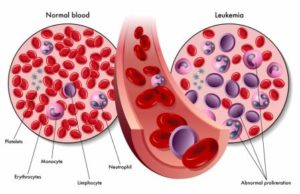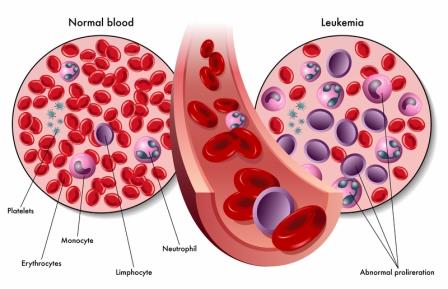“Your dog has leukemia,” your vet tells you, “which is an out-of-control growth of white blood cells.” My vet never used the term cancer. Although leukemia does not form tumors, it is a cancer of the blood.
The vet may then rattle off terms like lymphocytic, or lymphoblastic (same thing), or myeloid leukemia. To simplify the vet may use the initials CLL or ALL (chronic or acute lymphocytic leukemia) or CML or AML (chronic or acute myeloid leukemia). These types depend on the rate of progression chronic vs. acute, and the type of cells affected.
I won’t go into many details here, but I will briefly discuss the different types, symptoms, and treatments, and provide references for more detailed information. My own dog, Cassie, had CLL and her illness is described on this page.
The cause of leukemia is not known, although a few breeds seem to develop it more often, such as German shepherds and golden retrievers. Males are slightly more likely to develop this disease than females. Most dogs are middle aged to older, although younger dogs can also develop leukemia.
Blood Cell Types
Blood consists of many types of cells, all of which form in the bone marrow.
- Red blood cells (RBC), which transport oxygen throughout the body;
- Platelets, which aid in the clotting the blood.
- White blood cells (WBC), which affect our immune system. There are several types of WBC, but the ones that can cause leukemia include;
- Lymphoblasts – these form lymphocytes. An overabundance of lymphocytes is called lymphocytic leukemia.
- Myeloblasts – these are immature WBC that develop abnormally. Myeloid leukemia occurs when the blood or bone marrow has an elevated number of these cells. It can also represent the presence of many abnormal RBC or platelets. This form of leukemia is much less common than lymphocytic leukemia.
One of the concerns with leukemia is the disproportionate number of WBC that compete with normal RBC and platelets to grow in the bone marrow. High counts of WBC also accumulate in the blood and spleen.

Symptoms
The chronic form of leukemia usually has no obvious symptoms and is often found during a routine blood test. Acute forms of leukemia may present vague symptoms such as lethargy, weakness, anemia, low appetite, fever, frequent bleeding or bruising (bleeding under the skin), swollen lymph nodes or an enlarged spleen.
The vet will run blood tests, possibly over the course of several visits to note changes, if a chronic form of leukemia is present and the WBC counts are only slightly elevated. A bone marrow aspirate is the most conclusive test to determine if leukemia is present. Other tests may include chest x-rays, urinalysis, and an abdominal ultrasound.
Treatments
Leukemia is not curable, but chemotherapy drugs can slow the growth of abnormal cells so that the blood levels of RBC and platelets remain in a more normal range. Treatment will depend on if the dog has the acute or chronic form of leukemia.
Acute leukemia may involve intravenous drugs, antibiotics, and possibly a blood transfusion, especially if the dog has severe anemia. Often the dog may only survive for a few months, but this will depend on the condition of the dog at the time treatment begins.
Chronic leukemia may only need monitoring until the WBC counts become elevated. Normal levels are less than 5,000 cells/µl, while treatment often does not occur until the cell count exceeds 50,000 cells/µl. Currently, the chemotherapy drug of choice is chlorambucil (Leukeran), which is given orally. Often the steroid prednisone is given to enhance the effectiveness of the chemotherapy drug. Many dogs can develop gastrointestinal upset from these drugs, so veterinarians may prescribe something to aid their digestion. Dogs with CLL may live for several years with a good quality of life. Over time, the dog may experience gradual weakness and other immune disease or cancers may occur.
Note that since chemotherapy drugs reduce the function of the immune system, it is critical to keep the dog away from other unfamiliar dogs that could harbor diseases such as at dog parks, groomers, pet stores, and other dog-friendly events.
Please visit Cassie’s CLL page to read about my experience with CLL. Also, please comment or send me an email or comment if you have had a pet with leukemia.
Other websites with more detailed information include:
http://wearethecure.org/learn-more-about-canince-cancer/canine-cancer-library/lymphoid-leukemia/
https://www.vetary.com/dog/condition/chronic-leukemia
http://www.petwave.com/Dogs/Health/Leukemia/Symptoms.aspx
https://www.cancer.gov/types/leukemia/patient/adult-aml-treatment-pdq
http://www.petmd.com/dog/conditions/cancer/c_multi_acute_lymphoblastic_leukemia?page=2

